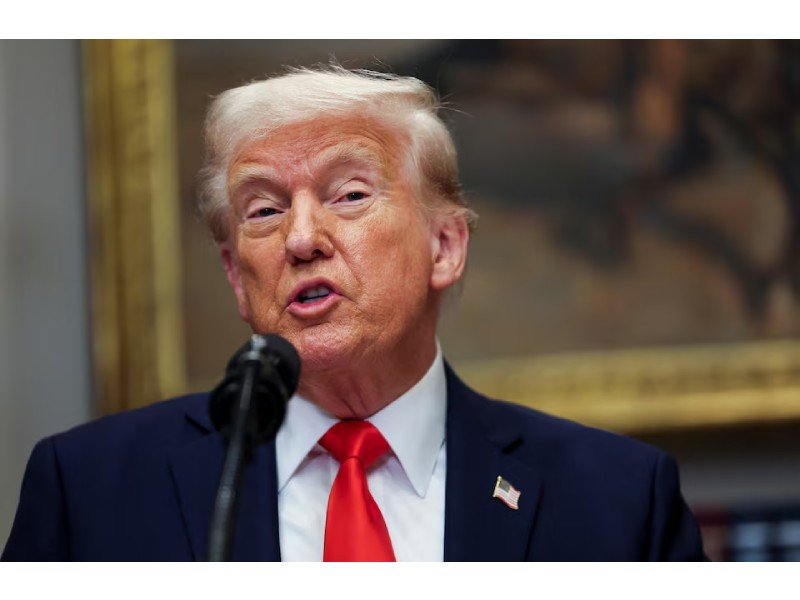- US President Donald Trump to finalize tariff decision on Canada and Mexico on Monday.
- Proposed tariffs include 25% on all imports and 10% on Canadian energy.
- Mexico and Canada urged to enhance border security and curb fentanyl inflow.
- Trump also expected to raise fentanyl-related tariffs on Chinese imports.
- Experts warn tariffs could impact the North American economy and global trade.
US President Donald Trump is set to finalize a decision on Monday regarding tariffs on imports from Canada and Mexico. The proposed tariffs include a 25% duty on all imports and a 10% tariff specifically on Canadian energy. The move is part of ongoing negotiations concerning border security and efforts to prevent the influx of fentanyl opioids into the United States.
Commerce Secretary Howard Lutnick confirmed the development on Sunday, calling it a “fluid situation.” The tariffs are scheduled to take effect at 12:01 a.m. EST (0501 GMT) on Tuesday. However, Lutnick hinted that the final tariff levels may be adjusted based on ongoing discussions.
Tariffs and Fentanyl: A Tougher Stance
Trump’s administration has tied the tariff decision to Mexico and Canada’s efforts to secure their borders and fight fentanyl trafficking. According to Lutnick, both nations have made progress, but they still need to do more. He emphasized that meeting the administration’s expectations requires stronger action and continued commitment.
“The Mexicans and the Canadians have done a nice job on the border,” Lutnick told CNN. “But they need to do more to stop fentanyl flows into the US. The president really cares about saving American lives, and tackling fentanyl is a key part of that.”
The CDC reported that 72,776 Americans died from synthetic opioid overdoses, mostly fentanyl, in 2023. Because of this alarming number, the administration views tariffs as a way to push neighboring countries to take stronger action. Officials believe that applying economic pressure could help curb fentanyl cartels and reduce the deadly drug’s impact.
Beyond tariffs on Canada and Mexico, Trump also plans to increase tariffs on Chinese imports linked to fentanyl production. Right now, the tariff stands at 10%, but it could jump to 20% if Beijing fails to step up. Although Lutnick did not confirm exact changes, he acknowledged that discussions about trade penalties are ongoing.
Mexico’s Response
Mexican President Claudia Sheinbaum addressed the issue in a press conference on Monday, stating that Mexico was prepared to respond if tariffs were imposed. “We have a Plan B, C, and D,” Sheinbaum said, without elaborating on the details.
She added that Mexico had already taken significant steps, including deploying additional security forces to its northern border and enhancing anti-drug efforts. “Our cooperation with the US on trade and fentanyl trafficking has been very good,” Sheinbaum stated.
Mexico has previously avoided Trump’s tariffs by negotiating last-minute agreements. In 2019, the country averted similar tariffs by agreeing to deploy troops to curb illegal migration into the US.
White House Stance on Trade Policies
White House trade adviser Peter Navarro reinforced Trump’s commitment to his tariff agenda. Speaking to CNBC, Navarro dismissed concerns about economic repercussions, stating, “The inflationary impact from tariffs will be minimal. The president knows that to make America strong and prosperous, with real wage growth and more factory jobs, this is the path he must take.”
The administration’s aggressive tariff strategy extends beyond Canada and Mexico. Last week, Trump announced a national security investigation into lumber and wood imports, which could result in new tariffs. Canada, already facing a 14.5% duty on softwood lumber, is expected to be significantly affected.
Broader Trade Actions
Trump’s recent trade measures include reviving a probe into digital services taxes, imposing fees on Chinese-built ships entering US ports, and launching a new tariff investigation into copper imports. These actions align with his broader strategy of “reciprocal tariffs”—matching the trade barriers imposed by other nations.
Economists warn that escalating tariffs could increase inflation and disrupt global trade. Desmond Lachman, a senior fellow at the American Enterprise Institute, cautioned that Trump’s “tariffs on steroids” could push the global economy toward recession.
US Tightens Duty-Free Import Rules for Canada and Mexico
On Sunday, the White House announced new restrictions on duty-free package imports from Canada and Mexico. Previously, the “de minimis” rule allowed shipments under $800 to enter the US tax-free. However, officials now aim to close this loophole to stop fentanyl traffickers. The ban will take effect once the US Commerce Department confirms that proper screening measures are in place.
Earlier this month, Trump suspended the de minimis exemption for Chinese imports. However, the implementation ran into delays because of logistical issues. US Customs and Border Protection struggled to screen packages efficiently, which caused major backlogs at airports. As a result, concerns grew over whether enforcement would be effective in handling large shipment volumes.
Trump’s tariff policies on Canada, Mexico, and China continue to spark economic and political debates. On one hand, the administration argues that these tariffs protect national security and ensure fair trade. On the other hand, critics warn that they could disrupt businesses and destabilize the economy. As discussions move forward, businesses and policymakers in North America remain uncertain about the long-term impact.


